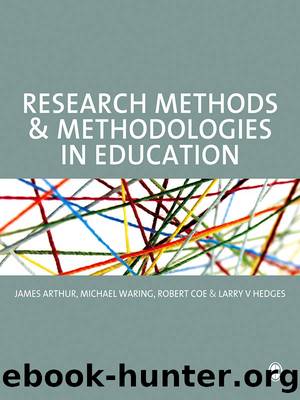Research Methods and Methodologies in Education by James Arthur & Michael waring & Robert coe & Larry v. Hedges

Author:James Arthur & Michael waring & Robert coe & Larry v. Hedges
Language: eng
Format: azw3
Publisher: SAGE Publications
Published: 2012-03-18T16:00:00+00:00
The computational turn
Over the past years, another significant approach to blog research has developed as part of what David Berry (2011) has described as the ‘computational turn’: the increased availability of tools for the semi-automatic capture and analysis of large corpuses of web (and other) content, and the development of research methodologies across the humanities and social sciences which exploit these new opportunities, often in interdisciplinary research teams. In blog research, the thrust of such developments is twofold: the earliest such research projects (see, for example, Adamic and Glance, 2005) focused mainly on the links found on blog sites and used them to plot the network structure which these multiple interlinkages reveal. This is done by using web crawler software – such as the freely available IssueCrawler (http://www.issuecrawler.net) – which start from a seed list of web pages provided by the researcher, and identify and follow the links present on those pages over a number of iterations to identify the wider network of sites which these seed sites link to. By analysing these linkage patterns, it is possible, for example, to identify those sites which receive the most links (and which can therefore be understood as key providers of information or opinion), those which link the most but do not receive many links themselves (that is sites which sit on the margins, looking in), and those which both receive many incoming links and frequently link to others (sites which, in network analysis terms, have the greatest centrality in the network and act as its key connecting hubs). Additionally, networks may also exhibit more or less pronounced clustering patterns, where sites in specific clusters are highly interlinked with one another but not with sites in rival clusters. In their study of political blogs during the 2004 US election campaign, for example, Adamic and Glance (2005) found that bloggers on either side of US politics interlinked strongly with like-minded authors but much more rarely connected to their political foes.
Such analysis is of interest well beyond the relatively narrow field of explicitly political blogging, however: it can provide information on the structuration of the blogosphere on a much larger scale, as well as on the internal structures of its smaller subsets that are based around shared interests or identities. It is important to note in this context, however, that conventional web crawlers tend to be somewhat limited in their capabilities on several major points: first, they tend not to be able to distinguish between blogs and other types of websites, and will need to be trained to ignore links which may be commonly present in the sites analysed but are irrelevant for the study itself (for example to Google search functionality or to blog platform providers like Wordpress or Blogger). An untreated corpus of links generated by a crawler may therefore include a range of links that need to be removed manually, depending on the specific aims of the network analysis.
Second, crawlers usually also fail to distinguish between different types of links found on the same blog.
Download
This site does not store any files on its server. We only index and link to content provided by other sites. Please contact the content providers to delete copyright contents if any and email us, we'll remove relevant links or contents immediately.
| Administration | Assessment |
| Educational Psychology | Experimental Methods |
| History | Language Experience Approach |
| Philosophy & Social Aspects | Reform & Policy |
| Research |
The Art of Coaching Workbook by Elena Aguilar(51076)
Trainspotting by Irvine Welsh(21568)
Twilight of the Idols With the Antichrist and Ecce Homo by Friedrich Nietzsche(18566)
Fangirl by Rainbow Rowell(9175)
Periodization Training for Sports by Tudor Bompa(8210)
Change Your Questions, Change Your Life by Marilee Adams(7684)
This Is How You Lose Her by Junot Diaz(6833)
Asking the Right Questions: A Guide to Critical Thinking by M. Neil Browne & Stuart M. Keeley(5708)
Grit by Angela Duckworth(5554)
Red Sparrow by Jason Matthews(5424)
Paper Towns by Green John(5136)
Room 212 by Kate Stewart(5070)
Ken Follett - World without end by Ken Follett(4682)
Housekeeping by Marilynne Robinson(4391)
The Sports Rules Book by Human Kinetics(4342)
Double Down (Diary of a Wimpy Kid Book 11) by Jeff Kinney(4240)
Papillon (English) by Henri Charrière(4227)
The Motorcycle Diaries by Ernesto Che Guevara(4050)
Exercise Technique Manual for Resistance Training by National Strength & Conditioning Association(4018)
